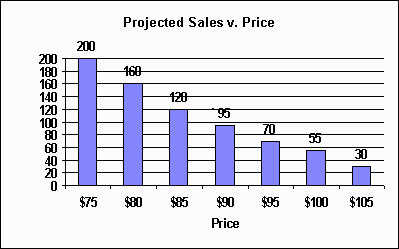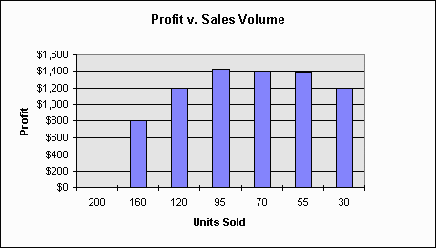| Modeling
Tool
When you go into business for yourself, you have to strike a balance between the risks that you assume and the return you expect to receive if you succeed. Obviously, no one likes to take big risks to obtain a small return. A business plan can be used as a modeling tool to look at a variety of scenarios.
This type of projection would commonly be based on market research into price elasticity (the extent to which demand for your goods or services is affected by price). Knowing that your cost to produce and sell each unit is $75, you can also project the overall profit you'll attain at various pricing levels. The profit is determined by subtracting the cost ($75) of each unit from the selling price and multiplying the result by the projected sales volume. Take a look:
As you can see, in this example, the profit remains relatively constant over a rather broad range of sales volume. A sales price of about $90 maximizes profit on sales of about 95 units. In this case, however, any sales price from $85 to $105 is projected to generate at least a $1,200 profit. So if $1,200 profit is acceptable, the unit sales could be as high as 120 units and as low as 30 units. This means that other factors, primarily operational, will be important considerations in setting a price. Merely maximizing net profit won't necessarily yield the best long-term result. Consider how different your business's needs would be if you produced 30 units versus 120 to produce the same net profit. This is the type of modeling that you can do if you have a
business plan to serve as an organized framework for considering
all the interrelated issues. Suppose you decide to accept a
somewhat lower overall profit in exchange for greater sales
volume. Will you have enough production capacity? Will you need
additional help? Have you got enough space to store that many
units? Can your suppliers provide the raw materials you need?
Answers to these and other questions are much more readily
available if you have a written plan as a modeling tool. |


